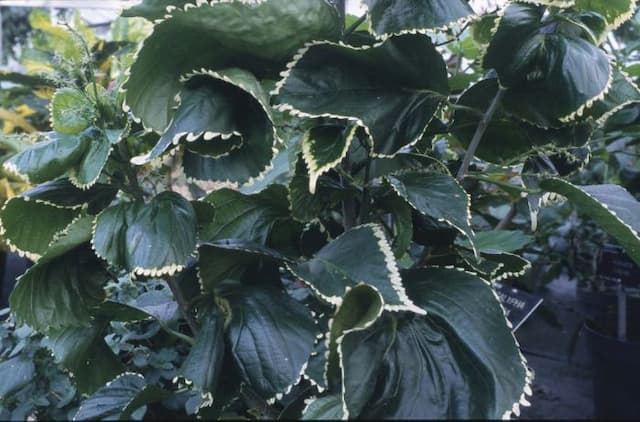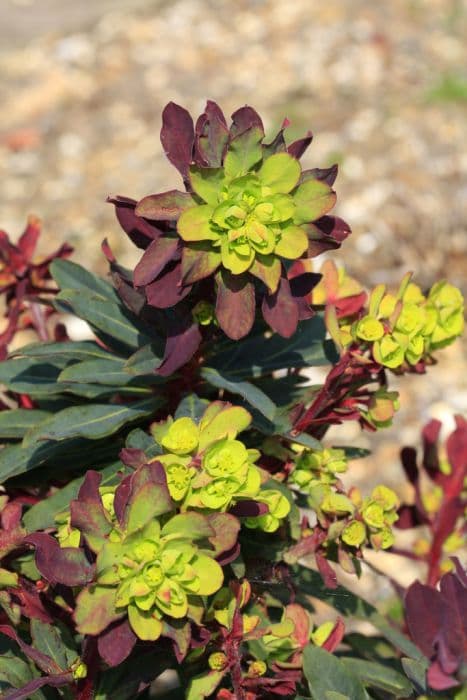Horned Spurge Euphorbia ceratocarpa

ABOUT
Euphorbia ceratocarpa, commonly known as Mediterranean Spurge, is a distinctive plant known for its unique appearance. It boasts a bushy habit, with branches that often radiate out from the center of the plant, creating a dense, rounded shape. The leaves of this spurge present themselves in a narrow, lance-shaped format, with a bright green color that can vary in shade. Some might have a slight blue or grayish tint, adding to the plant's visual interest. Prominently, the Mediterranean Spurge is celebrated for its striking floral display. It carries clusters of small, inconspicuous flowers, which are actually complex structures consisting of a central female flower surrounded by male flowers, enclosed within a cup-like involucre. This involucre is often a vivid green, with contrasting hues at the center ranging from yellow to red, giving the impression of a colorful eye-catching bloom. Adding to its ornamental features, some stems and the central part of the flowering structures can exhibit reddish, purplish, or pinkish tones, especially as the season progresses. This complements the greenery and creates a delightful contrast that can be a focal point in landscapes. The whole plant is topped with a milky sap, which is characteristic of many spurges, and this sap is a defense mechanism against herbivores. However, it's worth noting that the sap is also an irritant to human skin and should be handled with care. Mediterranean Spurge has a robust and sturdy form, and although specific measurements are not detailed, it's implied that the plant can develop into a substantial presence in gardens due to its bushy and spreading nature.
About this plant
 Names
NamesFamily
Euphorbiaceae
Synonyms
Horned Spurge
Common names
Tithymalus ceratocarpus, Euphorbia ceratocarpa.
 Toxicity
ToxicityTo humans
Euphorbia ceratocarpa, commonly known as Euphorbia, is considered toxic to humans. The plant contains a milky sap known as latex, which is present in all parts of the plant. This sap contains compounds that can cause skin irritation and inflammation upon contact. If the sap comes into contact with the skin or eyes, it can lead to dermatitis, redness, swelling, and in severe cases, blistering. If ingested, the latex can cause severe irritation to the mouth, throat, and digestive system, leading to symptoms such as nausea, vomiting, and diarrhea. Ingestion can be very painful and potentially dangerous, warranting medical attention. In some individuals, ingesting parts of the Euphorbia potentially can lead to more severe reactions, including difficulty in breathing, and systemic involvement that might require emergency intervention.
To pets
The Euphorbia, commonly known as Euphorbia, poses a significant risk of toxicity to pets. The plant's milky sap contains irritant chemicals that can be harmful if any part of the plant is ingested. Contact with the sap may also cause skin and eye irritation. If a pet consumes parts of the Euphorbia, symptoms of poisoning can include oral irritation, drooling, vomiting, diarrhea, and, in severe cases, abdominal pain or signs of distress. As with humans, if the sap gets into the eyes, it can cause pain, redness, and swelling. Due to the risk of severe irritation and gastrointestinal upset, any suspected ingestion warrants prompt veterinary attention.
 Characteristics
CharacteristicsLife cycle
Perennials
Foliage type
Deciduous
Color of leaves
Green
Flower color
Yellow
Height
3 feet (0.91 meters)
Spread
2 feet (0.61 meters)
Plant type
Shrub
Hardiness zones
7
Native area
Mediterranean
Benefits
 General Benefits
General Benefits- Drought Tolerance: Euphorbia ceratocarpa is highly tolerant to drought conditions, making it suitable for xeriscaping and water-wise gardens.
- Low Maintenance: Once established, it requires minimal care, making it ideal for gardeners seeking low-maintenance plants.
- Landscape Interest: The unique shape and texture of Euphorbia ceratocarpa add visual interest to landscapes, gardens, and arrangements.
- Erosion Control: Its root system helps to stabilize soil and prevent erosion on slopes and in dry regions.
- Attracts Wildlife: The plant can attract certain species of birds and insects that feed on the nectar or use it for habitat.
- Adaptability: Euphorbia ceratocarpa can adapt to a wide range of soil types as long as there is good drainage.
- Year-Round Interest: With evergreen foliage, it provides year-round color and structure in the garden.
 Medical Properties
Medical PropertiesThis plant is not used for medical purposes.
 Air-purifying Qualities
Air-purifying QualitiesThis plant is not specifically known for air purifying qualities.
 Other Uses
Other Uses- Euphorbia ceratocarpa, commonly known as Horned Spurge, can be used in xeriscaping and low-maintenance gardens due to its drought-resistant properties, providing an aesthetic appeal without requiring frequent watering.
- The milky sap of Horned Spurge may serve as a natural pest deterrent in gardens, as some insects avoid plants with this type of sap.
- The unique shape of Horned Spurge can be incorporated into spiritual or meditative gardens, where its structural form adds to the contemplative ambience.
- Artists may use the dried stalks and unusual seed pods of Horned Spurge in floral arrangements or as inspiration for sculptural pieces and nature-based art.
- Horned Spurge can play a role in soil stabilization on slopes or areas prone to erosion, as its root structures help to anchor the soil.
- When planted in groupings, Horned Spurge can act as a natural windbreak in areas where winds are strong and unrelenting.
- Educationally, Horned Spurge can be used to teach about plant defense mechanisms, demonstrating how certain plants use toxic sap to protect against herbivory.
- Photographers and nature enthusiasts might be intrigued by the photogenic qualities of Horned Spurge, especially during its blooming season, for its distinct appearance.
- Horned Spurge can serve as a living seasonal indicator; given that it has a specific period of growth and dormancy, it can be observed for educational purposes related to plant life cycles and phenology.
- The way Horned Spurge adapts to arid environments can be studied in ecological and environmental science fields, deepening the understanding of plant adaptations to climate stressors.
Interesting Facts
 Feng Shui
Feng ShuiThe Euphorbia ceratocarpa, commonly known as Horned Spurge, is not used in Feng Shui practice.
 Zodiac Sign Compitability
Zodiac Sign CompitabilityThe Horned Spurge is not used in astrology practice.
 Plant Symbolism
Plant Symbolism- Adaptability: Euphorbia ceratocarpa, commonly known as Horned Spurge, often thrives in various environments, symbolizing the ability to adapt to different circumstances.
- Protection: The plant contains a milky sap that is toxic and can cause irritation, symbolizing defense and the need for setting boundaries.
- Resilience: As a plant that can handle tough conditions, Horned Spurge represents perseverance and the capacity to withstand challenges.
- Purification: Historically, some Euphorbia species were used for medicinal purposes, which can symbolize cleansing and healing.
 Water
WaterThe Thorny Spurge (Euphorbia ceratocarpa) should be watered sparingly, as it is drought resistant and prefers dry to medium moisture soil conditions. Generally, the plant requires watering once every one to two weeks, depending on the climate and soil dryness, with a reduction in frequency during the winter months. Allow the soil to dry out between waterings and water deeply, providing approximately 8-16 ounces of water per square foot of soil. Over-watering can lead to root rot, so ensure good drainage and avoid letting the plant sit in waterlogged soil.
 Light
LightThe Thorny Spurge prefers full sun to partial shade conditions and thrives best when provided with plenty of sunlight. Ideally, place the plant in a spot where it receives at least six hours of direct sunlight daily. While it can tolerate some light shade, too little light may stunt the plant's growth and reduce its vibrancy.
 Temperature
TemperatureThe Thorny Spurge is adapted to a wide range of temperatures but prefers to be in an environment where temperatures are between 50°F and 85°F. The plant can survive temperatures as low as 30°F and as high as 100°F, however, it’s important to protect it from frost and extreme heat waves to prevent damage.
 Pruning
PruningThe Thorny Spurge should be pruned to remove any dead or damaged stems and to maintain its shape. Pruning is best done in the late winter or early spring before new growth begins. This not only keeps the plant looking tidy but also helps prevent potential disease and encourages healthier new growth.
 Cleaning
CleaningAs needed
 Soil
SoilThe ideal soil mix for Horned Spurge (Euphorbia ceratocarpa) is fast-draining, such as a cactus potting mix with added perlite or sand to enhance drainage. The soil pH should be slightly acidic to neutral, around 6.0 to 7.5.
 Repotting
RepottingHorned Spurge (Euphorbia ceratocarpa) should be repotted every two to three years or when it has outgrown its current pot.
 Humidity & Misting
Humidity & MistingHorned Spurge thrives in moderate humidity levels, but it is tolerant of lower humidity, making it suitable for typical home environments.
 Suitable locations
Suitable locationsIndoor
Provide bright light, well-draining soil, and minimal water.
Outdoor
Plant in well-draining soil, full sun to partial shade.
Hardiness zone
7-11 USDA.
 Life cycle
Life cycleEuphorbia ceratocarpa, often known as Horned Spurge, begins its life cycle as a seed, usually dispersed by the dehiscence of the fruit that explosively releases the seeds. Upon finding suitable soil conditions, the seed germinates, typically in the spring, and a small root system and shoot develop. As the plant establishes, it forms a strong taproot and a rosette of leaves close to the ground. The Horned Spurge grows rapidly, developing a branching, upright stem structure and oblong leaves, and can reach heights of up to 50-60 cm. Throughout the summer, it produces yellow-green, inconspicuous flowers surrounded by showy bracts, which are pollinated by insects, leading to the formation of the characteristic horned seed capsules. After seeds are dispersed, the plant generally dies back in the winter, completing its annual life cycle, though some may behave as short-lived perennials in milder climates.
 Propogation
PropogationPropogation time
Spring-Early Summer
Propogation: Euphorbia ceratocarpa, commonly known as horned spurge, can be propagated primarily through seed. The best time to sow seeds is in spring after the last frost when the temperature begins to warm up. The seeds should be sprinkled on well-draining soil and lightly covered with a thin layer of soil or sand. They need to be kept moist until germination, which usually occurs within two to three weeks. This method allows for a new generation of plants that are genetically diverse and can be a simple and cost-effective way to expand your garden with horned spurge.



![Spurge [Blackbird]](/_next/image?url=https%3A%2F%2Fplants-admin.emdemapps.com%2Fimages%2Fplants%2F%2Fimages%2F604b535f37783.png&w=640&q=75)





